“Order is survival.” – Dominium maxim, etched above the Hall of Accord in Tessalin.
An assembly of Dominium citizens on the icy surface of Tessalin beneath their synchronized orbital rings.
Dominium society values order and unity, evident in the identical uniforms and disciplined ranks of its people. In the sky above, massive geometric ring-stations orbit the planet in perfect sync – a living clockwork of habitats that Dominium built to house their civilization.
These rings move with mathematical precision, a testament to Dominium engineering and their need to regulate even cosmic rhythms. Tessalin itself, once a frozen wasteland, was transformed into a perfectly scheduled administrative world where even sunrise follows a protocol.
| Leader | Supreme Administrator Celeste Orikov (as of Cycle 150) |
| Ideology | Technocratic Collectivism – humanity as a unified mechanism, enforced order for survival |
| Founded | circa Year 0 Post-Exodus (the First Interstellar Jump) |
| Home System | Etalor – A-type white star (stable spectra) |
| Capital | Tessalin – Icy bureaucratic planet (heavily terraformed and regulated) |
| Motto | “Order is survival.” (Harmony over individuality) |
Origins and the Exodus
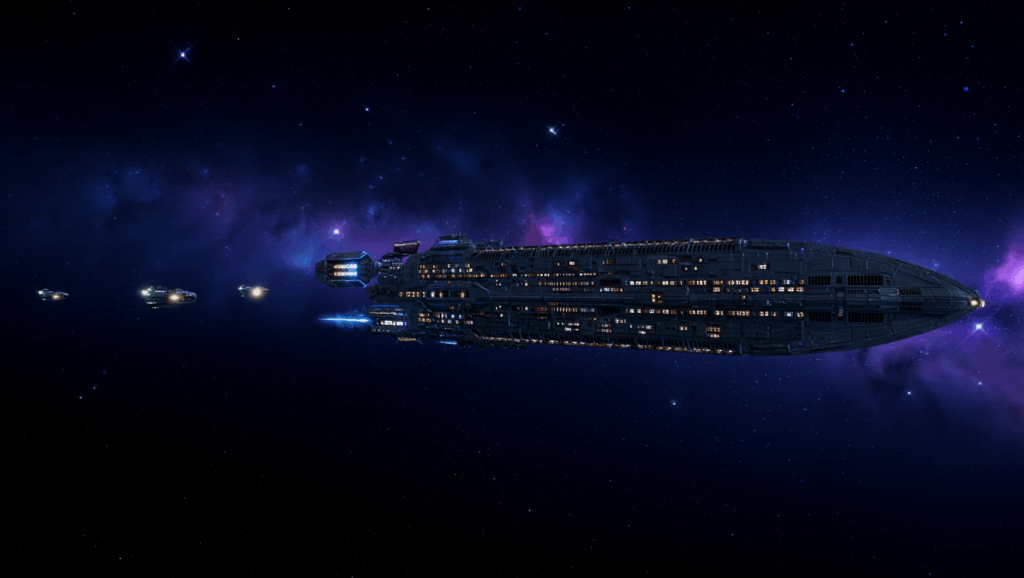
Dominium traces its origin to the Great Interstellar Exodus, a desperate departure from humanity’s ancestral cradle. Unlike the other descendants of that exodus, the founders of Dominium were never planet-bound colonists – they were born and raised in the controlled environment of an enormous space station.
This station, known in historical records as the Etalor Core, was an artificial habitat built in Earth’s orbit just before the jump to the stars. It was humanity’s first mega-station, designed as a self-contained ark of civilization. Its inhabitants – the proto-Dominium – grew up under steel skies and neon constellations, instilled from birth with a belief that survival depended on strict adherence to systems.
When the Exodus fleet made the interstellar jump toward the black hole (Gravis), the Etalor Core carried those who would become Dominium. These people left Earth behind not with wistful glances, but with clinical determination – their eyes already on a new order among the stars.
Protocolized Path to the Stars
In the early days of the journey, chaos and panic plagued many refugee fleets, but on the Etalor Core station life remained tightly regimented. The station’s governance was overseen by a council of engineers, philosophers of order, and AI administrators collectively called the High Directive.
They codified rules for everything: from how resources were rationed to the exact timing of “day” and “night” cycles under the station’s artificial lights. Each citizen had a role, and each role had a manual. This hyper-organized approach proved effective at maintaining stability aboard the ark. While rumors spread of riots or breakdowns on other colony ships, the Etalor Core reported zero major incidents during transit – a fact Dominium history books still cite with pride (and perhaps a touch of smugness).
However, the seeds of future conflict were also planted in this era. The High Directive’s insistence on order extended beyond their station – they attempted to coordinate and control the broader refugee flotilla by issuing protocols to other ships. Some fleets complied, but others bristled at Dominium’s authoritarian approach. Tensions simmered as Dominium’s leadership increasingly treated deviation as treason.
Surviving records hint that during the frantic Exodus, Dominium command even advocated sacrificing certain “non-compliant” colony groups to preserve resources for the rest. This proposal – essentially viewing some desperate colonies as expendable – would later be remembered (especially by Aronia) as the first act of triarchic atrocity.
The Great Consolidation in Etalor
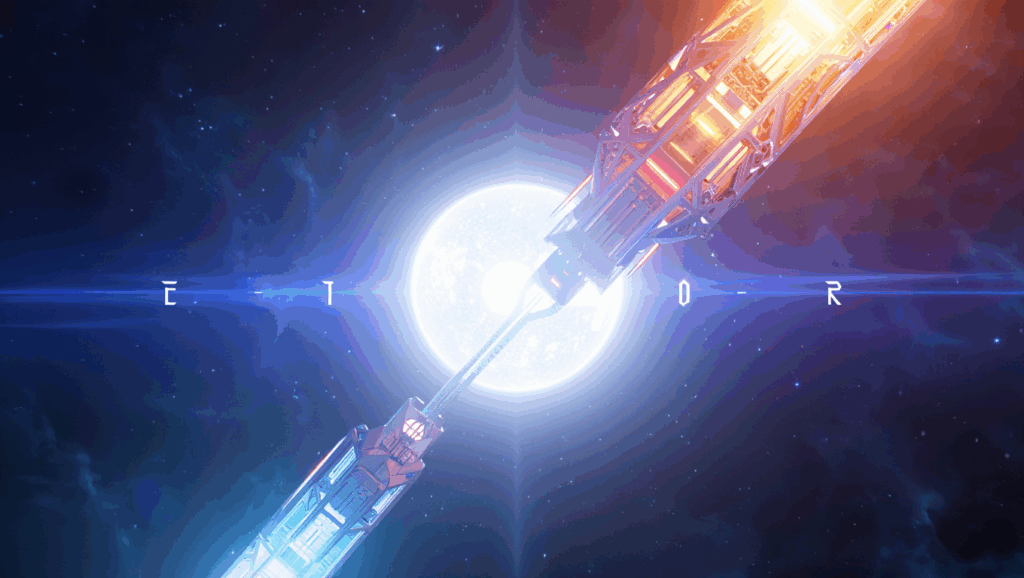
When the Exodus fleet finally arrived in the new cosmic region, three stars orbiting the black hole Gravis became hubs for the splintering human groups. Dominium chose the cold, bright star Etalor for its new home, drawn to its stable output and predictability. Around Etalor’s lone icy planet, Tessalin, Dominium enacted what historians call the Great Consolidation.
This was a period of frenetic construction and social engineering spanning the first few cycles (years) after arrival. The Etalor Core station was disassembled and rebuilt in orbit of Tessalin, expanding into multiple giant ring-shaped structure stations that encircle the planet in orbital bands.
These megastructures, perfectly geometric in design, were linked and synchronized like the gears of a colossal clock. They became the new “homeland” of Dominium – a habitat of metal and logic, where living on an actual planet was almost an afterthought.
Tessalin: The Protocol City
Tessalin itself served initially as a mining outpost and later as the administrative center. Dominium teams landed on the frigid surface and erected a capital city known as Protocol Prime (later simply called Tessalin Central).
Every aspect of this city was pre-planned: grid-layout districts, function-specific zones (a Bureaucratic Quarter, a Science Forum, etc.), and timing systems that regulated everything from public lighting to the citizens’ daily schedules.
In an audacious feat, Dominium engineers even adjusted Tessalin’s rotation and orbital period by deploying gravitational engines. The result was a “perfect year” synchronized to their station clocks, ensuring that a sunrise or sunset would occur exactly on schedule, neither a minute early nor late.
Folk tales in Aronia later mocked this project, claiming Dominium tried to edit time itself to fit in a spreadsheet, but Dominium’s leaders hailed it as the ultimate triumph of civilization over chaos.
Establishment of Hierarchy and Infrastructure: Ministries, Seals, and Unions
During the Consolidation, the Dominium society formalized its hierarchy. A technocratic government was established, led by the Supreme Administrator (a title held at first by the very same chair of the High Directive from the Exodus).
Under this centralized authority, an expansive network of ministries and regulatory bodies rapidly emerged, including:
- Ministry of Harmonization – Responsible for cultural management and societal unification
- Ministry of Resource and Infrastructure – Oversees energy, logistics, and planetary architecture
- Committee of Scientific Oversight – Maintains scientific standards and supervises innovation protocols
- Justice Tribunal – The highest judicial body, codifying order and protocol enforcement
- Ministry of Silence – A bureau for communicative ethics, famously known for its 400-page Silence Manual on the proper use of silent moments in interpersonal and state communication
Every citizen was catalogued and assigned a place in this grand machine. Births, education, careers, even marriage (which they tellingly call “Union Contracts”) were all subject to approval and scheduling by central authorities.
Information Seals and Identity Control
It was also in this era that Dominium adopted the practice of Information Seals – bio-digital identification tags every person wears embedded in their uniform collar or even beneath the skin. The Seals display one’s rank, role, and compliance record.
To a Dominium citizen, these are badges of honor; to an outsider, it makes Dominium crowds look like regiments of walking barcodes. Individual expression in appearance was minimized; utilitarian jumpsuits of gray or slate blue became standard attire (a practical choice that conveniently also discouraged any flamboyance).
Art and humor were not outright banned, but subjected to heavy scrutiny for “harmonious content.” One internal memo famously remarked,
“A joke is a tool, not a reason for chaos.”
The Survival System: Eradication of Crime, Childbirth Permits, and Thought Licenses
Despite the almost dystopian rigidity, the Dominium model worked – at least on its own terms. In a mere decade after arrival, Dominium had eliminated hunger and poverty within its realm (every resource was accounted for and redistributed efficiently).
Crime was virtually non-existent (deviant thoughts themselves were discouraged – the notion of requiring a permit for spontaneous ideas, which started as a satire, nearly became law). The population of Dominium grew steadily but under strict control, as families had to apply for childbearing licenses to prevent any resource strain.
In the official Dominium narrative, this period of consolidation is a golden age of order: humanity saved from its own worst impulses by a benevolent iron hand. Of course, outside that narrative, others saw it differently – to independent-minded survivors in the other factions, Dominium’s rise was the emergence of an Orwellian overlord that would soon seek to impose its will on everyone. And they were not wrong.
War of Protocol (First Triarchic Conflict)

Dominium’s sense of sole legitimacy – the belief that it was the rightful heir of human civilization – inevitably brought it into conflict with the other fledgling factions. The first and most tragic of these confrontations was with those who would later call themselves Aronia.
What Dominium viewed as an unacceptable breach of order (some ragtag colonies ignoring central command), the Aronians saw as survival and freedom. Tensions that began during the Exodus now exploded into open hostility once both groups had found their footing around their new stars. Roughly a dozen cycles after the Exodus, Dominium made its move to “bring harmony” to the rest of humanity, by force if needed.
The immediate spark was Dominium’s demand that all human communities register under a unified Interstellar Charter authored on Tessalin. This charter would effectively put every colony or ship under Dominium’s bureaucratic oversight.
The Aronian colonies in the Valereon system flatly refused. According to Aronian oral history, a Dominium envoy delivered an ultimatum to one of their floating cities and was answered with a burst of uncontrolled laughter from the free-spirited colonists (this story may be apocryphal, but it’s very much in character for both sides).
Enraged and “to set an example,” the Dominium Central Command authorized a military “Protocol Enforcement Operation.” Thus began what came to be called the War of Protocol – known to Aronia as the War of Independence and grimly remembered for the Exodus Genocide at its outset.
The Mirassi Genocide
Dominium’s forces, comprised of disciplined fleets of uniform gray warships, descended upon the Valereon system. At the time, Aronian communities were scattered and less advanced in weaponry, still recovering from earlier hardships.
Dominium targeted what they identified as the largest “deviant colony” – a settlement on the partially ruined planet Mirassa. In a strike that Dominium logs coldly refer to as “Operation Standardization,” orbital bombardments were carried out on Mirassa’s surface installations when the colonists refused to surrender. Thousands perished in minutes.
Entire generations of survivors who had escaped one cataclysm were eradicated by another – this time at human hands. Dominium believed a swift, overwhelming show of force would compel all other dissidents to capitulate.
Instead, it had the opposite effect: it galvanized the scattered survivors into a furious resistance and etched an eternal hatred of Dominium in their hearts. This atrocity is what Aronia calls the Mirassa Genocide, part of the larger “genocide during emergency expansion” that shaped their identity. To this day, Aronian elders with nano-scar tattoos on their bodies will recount how “only those who chose life over rules made it through” that dark time – a direct rebuke to Dominium’s rigid doctrine.
Partisans, Beams, and Defeats: Aronia’s Unexpected War
The conflict widened after Mirassa. Far from surrendering, Aronian fighters took to their fleet ships and adopted guerrilla tactics. They knew the Valereon system’s volatile environment intimately and used it to their advantage. In one famous incident, a squadron of Dominium drones pursuing Aronian “dance-capsule” ships (small, swift vessels) were lured directly into a region of intense solar flares from Valereon.
The radiation and magnetic chaos disabled the drones en masse – an event Aronia commemorates in song as the “Flare Waltz” and Dominium dryly catalogued as:
“Navigation hazard incident.”
Skirmishes like this proved Dominium’s campaign would not be the quick police action they expected. The Aronians, motivated by survival and vengeance, fought ferociously and unpredictably – off-protocol, one might say – which confounded the Dominium navy.
Ortaz: The Third Force Awakens
To make matters more complex, a third player emerged: Ortaz, the faction of post-human uploaders in the nearby Siero system.
Initially, Dominium wasn’t sure what to make of Ortaz. The Ortazians had not engaged in open hostilities and communicated only sporadically in abstruse messages. However, Dominium’s paranoia soon got the better of them. Fearing that Ortaz might align with Aronia or pose a different kind of threat (after all, Dominium ideologues argued, “are digital post-humans even still human, or a form of rogue AI?”), Dominium moved to assert control over Siero as well.
They dispatched a delegation with demands that the Ortaz collective submit to regular “Inspection and Integration” under Dominium law. One can imagine the bemusement of the Ortaz at this idea – the uploaded minds responded with polite incomprehension, essentially stating that physical constraints and linear laws did not fully apply to them. Receiving only cryptic replies, Dominium grew more suspicious.
Cyberattack, Rhymed Fiasco, and Spatial Distortion
The war against Aronia thus risked expanding into a war against Ortaz. Dominium intelligence units attempted a cyber-infiltration of the Ortaz Archive, hoping to find vulnerabilities or at least map their network.
According to later Ortaz revelations, the Dominium hackers were absorbed into a sort of sandbox simulation the Ortaz had prepared – in other words, the would-be attackers were tricked into chasing false data in a fake virtual world, while the Ortaz studied their tactics.
The Dominium agents eventually realized they had been duped when one reported that his hacking interface was responding with limericks about the futility of control. Embarrassed and alarmed, Dominium Command considered this a hostile act. A task force of real-world ships was sent toward Siero to “secure the Archive” by force.
What happened next is shrouded in both mystery and propaganda. Dominium officially records that their fleet experienced “anomalous spatial distortions” on approach to Siero, resulting in the mission being aborted. Crewmembers later described what felt like:
- Time slowed down to the point of pain
- Gravitational waves emitted illogical signals
- Navigation became impossible
- Some officers claimed to have experienced time loops and even hallucinations
It is widely believed that the Ortaz employed the unique properties of their blue dwarf star (and their mastery of “shadow time” technology) to create a non-linear barrier, essentially a zone where space-time was so warped that the Dominium ships couldn’t advance or even communicate properly.
After days of futile effort, in which some Dominium officers reportedly lived through hallucinations or looped time experiences, the task force retreated, having never fired a shot. Dominium spun it as:
“Technical failure”
Ortaz quietly demonstrated that they could not be subjugated by conventional means.
When War Outpriced Itself
Facing protracted resistance on two fronts and unable to secure a quick victory, Dominium’s Supreme Administrator and her council grew concerned that the costs of this war of unification were outweighing the benefits. There were minor mutterings within Tessalin about the mounting casualties (hard as it is to believe, not every Dominium citizen was entirely on board with killing fellow humans in the name of order).
Additionally, some of Dominium’s calculations predicted that if the war dragged on, it could even jeopardize their precious internal stability. Thus, reluctantly, Dominium agreed to talk.
Diplomats from all three factions established a ceasefire and arranged a historic meeting at a neutral location near the gravitational center that bound them: Gravis Central, the black hole.
The Gravis Truce and “Harmonious” Stalemate
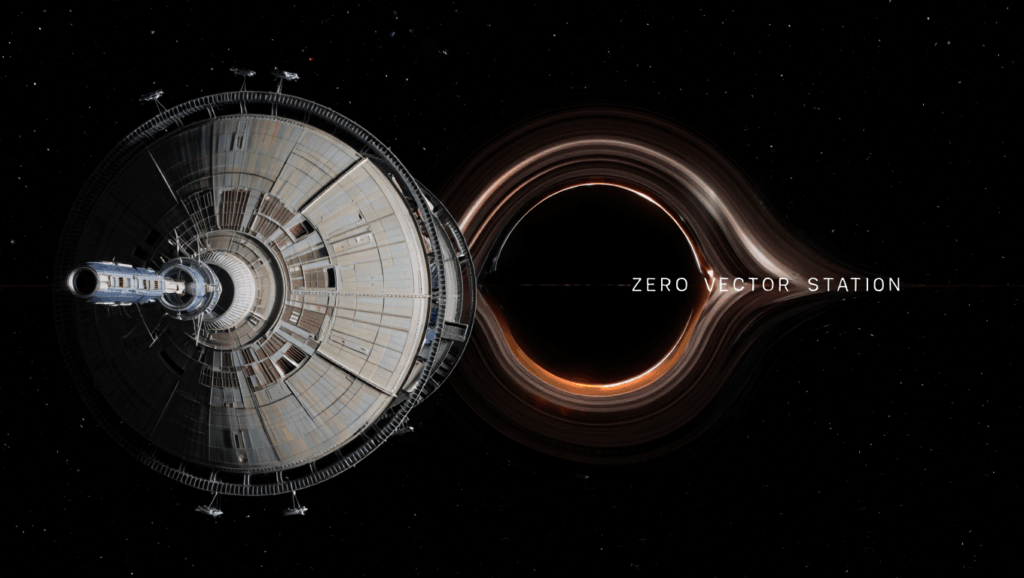
The negotiations at the black hole’s edge led to the Gravis Truce, essentially a stalemate peace accord that has, amazingly, lasted roughly 147 cycles since the War of Protocol.
The meeting took place on an orbital platform that came to be known as Zero Vector Station, positioned just outside the event horizon of Gravis. Accounts describe a tense but awe-inspiring summit:
- On one side, Dominium envoys in crisp uniforms and emotionless visors;
- On another, Aronia’s patchwork delegation of scarred survivors and passionately eloquent Monuments (some reportedly broke into song mid-negotiation, unsettling the Dominium side);
- And on the third, the Ortaz presence – a single humanoid avatar draped in symbolic cloth, speaking rarely but with an echoing, musical cadence when it did.
The resulting accord was not a grand reconciliation, but it established a balance of power.
Dominium recognized the de facto autonomy of Aronia and Ortaz, abandoning its claim to govern all humans (though never renouncing the belief internally). In return, Aronia and Ortaz agreed to a general non-aggression principle and to respect certain neutral zones around Gravis Central and between territories.
Space was essentially carved up: Etalor system for Dominium, Valereon system for Aronia, Siero system for Ortaz. The black hole Gravis and its immediate surroundings were declared an Open Neutral Territory – off-limits to colonization or unilateral military action, given its philosophical and strategic importance.
Dominium likely pushed for that clause to prevent Aronia from recklessly diving into it or Ortaz from doing whatever bizarre thing they might with it.
Despite the grudging peace, Dominium left the talks with a sense of moral victory – in their view, they had managed to “contain the chaos”. They spun the truce as a calculated strategy: better to quarantine the irrational elements (Aronia’s anarchic lifestyle and Ortaz’s post-human anomaly) than to waste resources in unwinnable conflict.
Dominium propaganda henceforth often referred to Aronia as a “quarantined cultural experiment” and to Ortaz as a “long-term monitoring project.” Publicly, Dominium taught its citizens that eventually the other two would either fail or voluntarily seek the stability of Dominium’s embrace. Privately, of course, Dominium continued to scheme ways to subtly influence or weaken the others over time.
The Triarchic Cold War

For decades after the war, an uneasy calm persisted – sometimes called the Triarchic Cold War. Dominium maintained a formidable navy and kept a constant patrol along the borders of its space. Any stray Aronian ship drifting too close to Etalor would be intercepted and politely (or not so politely) escorted back.
Likewise, Dominium intelligence worked ceaselessly: spies and informants tried to infiltrate Aronian communities (usually failing spectacularly – Aronians could sniff out a stuffy Dominium agent in minutes), and viruses probed Ortaz networks (only to be turned into art installations by clever Ortaz counter-hackers).
Dominium’s Ministry of Truth produced countless reports on the “depravity and instability” of life in Aronia, painting the free folk as dangerous hedonists always one step away from collapse. And yet, to the frustration of Tessalin’s top brass, Aronia did not collapse; if anything, they appeared to thrive in their own unconventional way.
Similarly vexing, Ortaz did not turn into a rogue AI catastrophe – they simply remained puzzling and hard to pin down, neither attacking nor acquiescing.
Within Dominium society, these long years of stalemate led to a doubling down on core values. The leadership preached that vigilance must never falter – any sign of “Aronian influence” or “Ortaz corruption” among Dominium citizens was swiftly suppressed.
For example, when a trend of unsanctioned music and improvised street theatre took hold among some Dominium youths (inspired by smuggled Aronian songs), the Ministry of Harmonization cracked down hard, instituting mandatory loyalty recitals of the Dominium anthem and increased monitoring of art.
There was even a minor rebellion at one point: a group of bureaucrats-turned-poets (calling themselves the Rhythm Renegades) attempted to distribute subversive poetry that questioned the joylessness of life on Tessalin. They were quickly arrested and enrolled in “Re-education through Order” programs. This incident, termed the Metered Rebellion, ended not with executions (Dominium preferred reform over martyr-making) but with the rebels publicly recanting their creative excesses in a televised ceremony. As a dry Dominium commentator noted:
“In the end, their meter was corrected.”
While dissidence in Dominium never vanished entirely (the human spirit can only be regimented so far), it remained rare and underground. The average Dominium citizen continued to live a life of comfort by material standards: clean, climate-controlled habitats, guaranteed work and sustenance, clear purpose – at the cost of personal freedom and spontaneity.
Most accepted the trade-off, having known no other life. Generations passed who had never set foot on natural soil or danced freely or seen an unscripted sunrise. To them, the idea of Aronia’s chaotic freedom was as frightening as it was foreign.
And Ortaz? Many Dominium citizens doubted Ortazians even existed in any meaningful human sense; they were bogeymen or curiosities whispered about but not encountered. After all, Dominium children were taught that “to abandon the body is to abandon humanity” – a direct rebuttal to Ortaz’s philosophy.
Ironically, the Ortaz would counter that by renouncing flesh, they saved their humanity, but such paradoxes found no place in Dominium textbooks.
Life Under Protocol: Culture and Technology
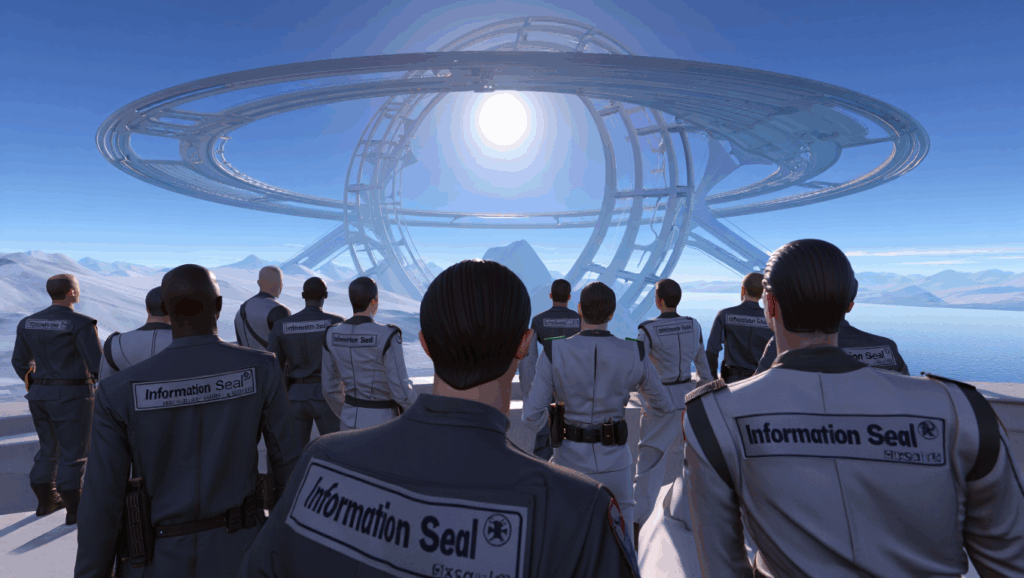
Life in Dominium is often described (by outsiders) as living inside a massive machine, and that’s not far from the literal truth. The structure-stations that house most of the population are marvels of engineering: enormous ringworlds and orbital platforms locked in synchronized dance around Etalor and Tessalin.
They are so precisely positioned that one can set a watch by when the shadow of one ring eclipses another. Inside these habitats, every hour of the day is scheduled. Citizens typically awaken simultaneously to a gentle chiming broadcast (the Morning Unison), report to their assigned duties, and enjoy two 15-minute recreation periods. Acceptable activities include:
- Calisthenics,
- Reading approved literature
- Attending a protocol briefing.
Variance is minimal; even the interior decor of quarters is uniform, save for small personal effect allowances (one might keep a family holo-photograph or a certificate of merit on the wall, but little else). It might sound drab, but the Dominium populace takes pride in this consistency – it is safe. It is said a child on Tessalin can recite the daily schedule before they learn to tie their shoes (not that shoelaces are common – Velcro is more efficient!).
Culturally, Dominium emphasizes collective achievement over individual fame. Monuments in Protocol Prime list the names of committees that accomplished great deeds rather than single persons.
A sort of ancestor-worship exists, but of the institutional ancestors: for example, the “Founding High Directive Council” is honored annually on Unity Day, with portraits of solemn administrators paraded through the capital’s Grand Hall (all looking rather similar in their austere suits).
Personal emotions are kept subdued in public; an old Dominium aphorism says,
“The nail that sticks out gets hammered down – for the good of the structure.”
Still, humans are humans, and private life finds its small freedoms. Some citizens indulge in secret hobbies like collecting antique mechanical watches (a paradoxical passion for those obsessed with timekeeping), or whispering forbidden jokes to trusted friends.
One declassified report noted that black-market Aronian music recordings had been circulating in one station – the fact that those citizens risked punishment just to hear unregulated music speaks volumes about the innate desire for expression trying to survive under the layers of order.
Technologically, Dominium excels in infrastructure, defense, and data management. They developed extremely reliable systems:
- Planetary orbit adjusters,
- Gravity modulators,
- Entire artificial ecospheres for food production,
- Personal AI assistants that monitor a citizen’s health and mood stability,
- AI reporting any “anomalies” of course.
Dominium artificial intelligence is advanced but tightly controlled – AIs are not autonomous; they are bound by strict ethical cores and overseen by the Ministry of Technological Integrity. The fear of rogue AI (partly why they distrust Ortaz) means Dominium will never allow an AI to self-modify or make decisions without human authorization.
Instead, AIs serve as advisors, record-keepers, and efficiency optimizers. It’s said that on Tessalin, nothing a person does is unobserved – the network of sensors and AI logs effectively creates a panopticon where every deviation is noticed. Most citizens long ago internalized this and self-censor even their thoughts. Which made the notion of a ‘License for Spontaneous Thoughts’ almost seem plausible — a satirical proposal that, alarmingly, nearly became policy.
One area Dominium deliberately lags is experimental bio-modification. Unlike Aronia, which embraces bioengineering freely, Dominium has conservative rules on human augmentation: anything that might introduce unpredictable changes in behavior or identity is frowned upon.
Minor cybernetic implants are common (mostly for interfacing with systems or medical purposes), but wholesale genetic tweaks or wild biological experiments are not. The reasoning: too much variation could disrupt social harmony.
There was one infamous incident known as the Gene Variance Scandal, where a group of scientists secretly introduced a mild creativity-enhancing gene therapy to a cohort of students to see if it improved problem-solving. When Dominium authorities discovered this unsanctioned trial, they shuttered the project and reassigned the scientists to menial posts. They weren’t punished severely, interestingly:
Dominium doesn’t burn heretics; it files them away.
But it was made clear that the collective decides the evolution of humanity, not renegade visionaries.
Toward the Event Horizon – Modern Challenges
As the cycles turned into a century and more, Dominium persisted, ever-watchful. But the galaxy did not freeze in the initial post-war pattern. Aronia continued to develop its own way, and Ortaz theirs, sometimes in surprising directions that Dominium analysts couldn’t predict.
Minor crises came and went:
- Resurgence of solar instability in Valereon, causing migrations (Dominium offered “assistance” which Aronia pointedly declined),
- Data-plague in Ortaz systems that Dominium fretted might spill over (it didn’t, and Ortaz solved it internally by literally dreaming up a cure in their digital realm),
- Even internal hiccups like a malfunction in one orbital ring’s life support that required temporary evacuation (handled with trademark Dominium calm and a thousand-page investigative report afterward).
Through all this, Dominium held to its mantra: stability above all.
The Three Factions Speak Again

In recent times, however, the unthinkable has happened: the three factions have started doing the oddest thing – talking to each other more. It began with small diplomatic exchanges and humanitarian gestures. For instance, in Cycle 138, an Aronian “Memory Ship” arrived unannounced in Tessalin orbit, broadcasting an offer to share some recorded histories and art as a peace token.
Panic gripped the Dominium military at first – was this a trick, a cultural invasion? The Supreme Administrator nearly ordered the ship shot down. But cooler heads prevailed; Dominium allowed it to dock in a controlled manner. The Aronian crew, mostly scholars and empathic historians, genuinely came to present Dominium with a digital archive of human experiences from the Exodus and even some Earth nostalgia, hoping to bridge the gap. The gesture was clumsy (Dominium media decried it as “emotional propaganda”), but it opened a crack in the wall.
Some Dominium citizens secretly marveled at the holo-visions of life beyond their own, and the administrators, though publicly skeptical, filed the encounter away as “non-threatening.”
Ortaz, on their part, reached out in their own surreal way. At one point, a Dominium relay station near Siero detected what appeared to be a Dominium protocol transmission, but encoded strangely. It turned out Ortaz had taught themselves one of Dominium’s bureaucratic languages to open communication, sending a message that offered a “data exchange of mutual philosophical interest.”
Intrigued and cautious, Dominium dispatched a team of logicians to interface with Ortaz representatives in a virtual meeting. This so-called Dialectic Summit lasted only a short while (the Dominium reps found the Ortaz thought patterns disorienting), but it did produce a document of common definitions – a baseline to understand each other better, however thin.
Gravis Central
Drivers behind these overtures included a new generation of leaders and the looming enigma of Gravis Central. The black hole at the center of their cosmic dance had always been a subject of awe and speculation. Dominium’s scientists have long studied it from afar, treating it like a dangerous riddle. Over time, evidence mounted that something lies deep inside the black hole – perhaps an artifact or a remnant of an ancient intelligence, something that could even alter reality itself (so the theories go). Each faction developed its own narrative around this possibility.
Dominium’s stance became that if an artifact exists, it must be contained or protected, lest its power upset the carefully maintained balance. A secret research division in Dominium, rumored to be called Project Aegis, has been quietly preparing contingency plans: from harnessing the artifact safely under Dominium supervision, to worst-case scenarios like triggering a controlled collapse of the wormhole around the black hole to seal it off.
As of the current cycle (~147 years after the truce), events have accelerated. Unusual readings from Gravis – slight fluctuations in mass and gravity beyond predicted models – have everyone on edge. Dominium suspects someone (or something) is meddling with the black hole. Naturally, suspicions fall on Ortaz (who have the technology) or Aronia (who have the audacity).
In Our Time: Preparing for an Unprecedented Moment
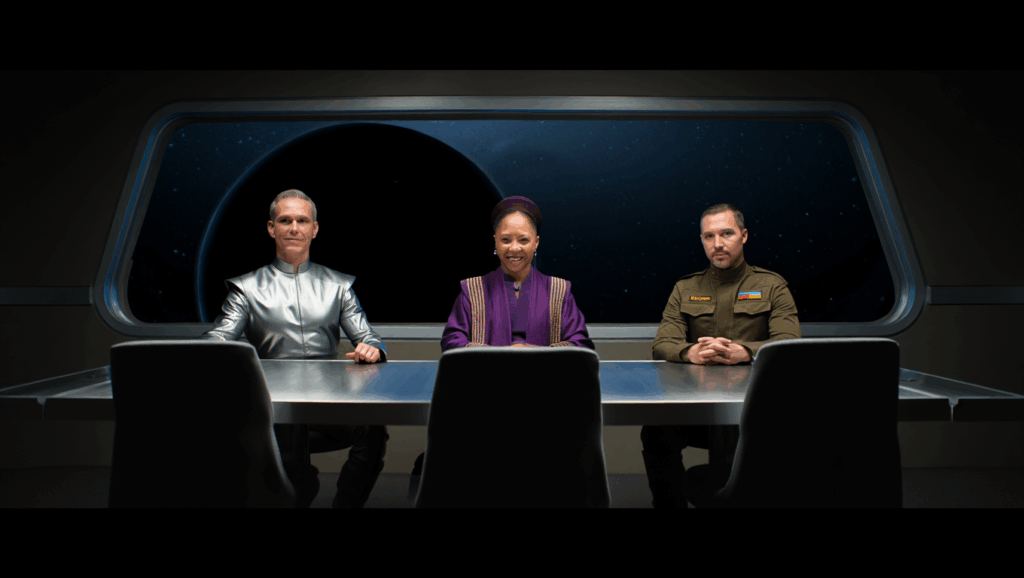
For once, Dominium’s instinct isn’t to mobilize for war, but rather to convene. The leadership calculated that a coordinated approach might be necessary; if the artifact is real, no single faction can deal with it alone without risking the wrath or intervention of the others. And so, astonishingly, Dominium agreed to a tri-faction summit – the first gathering of all three since the war’s end.
The announcement of this meeting was itself historic. When Aronia’s fleets began moving toward Gravis without formal permission (they just followed their hearts, as usual), Dominium at first lodged a complaint about the “protocol violation”. But quickly they realized they had to join rather than protest.
Supreme Administrator Celeste Orikov gave a carefully crafted statement to the Dominium populace, framing the gathering as a “necessary risk, calculated for the future of the species”. In Dominium terms, that’s a very enthusiastic endorsement.
The meeting is set for Zero Vector Station once again, hovering at the edge of the event horizon – a symbolic and literal midpoint. Preparations on Tessalin have been meticulous: teams of diplomats are rehearsing every possible dialogue tree (with pre-approved responses, naturally), security personnel have catalogued acceptable “heart-carried weapons” (Dominium interprets the no-weapons rule as allowing perhaps a ceremonial dagger of duty or the weight of their conviction), and a list of “Most Human Object” candidates to bring has been debated fiercely by committees (current top contender: an old mechanical clock from Earth, representing human ingenuity and order through time – fitting, if a bit on-the-nose).
No one in Dominium openly says it, but there is a mix of excitement and dread in the air. Many citizens, even those who’d never admit it, are curious about what will transpire when their long-estranged kin, the passionate Aronians and the ethereal Ortazians, meet with them in shared purpose. Could this herald a new chapter of cooperation, or will it simply reinforce Dominium’s conviction that only they stand between humanity and chaos?
Officially, Dominium remains cautious. Unofficially, some in the corridors of power see opportunity: if Dominium can steer the conversation, they might reaffirm their role as the anchor of the Triarchy, perhaps even persuade a few Aronians or Ortazians to see the “wisdom” of structured unity. And if the artifact in Gravis Central truly can alter reality, you can bet Dominium will push to lock it down, with a bureaucratic seal and key.
As Dominium’s delegation embarks for the black hole, one of their chroniclers writes in a memo:
“Galactic stability is when all three factions simultaneously fail to understand each other.”
In a way, Dominium has counted on that stability for a long time – each faction stuck in its own loop. Now, as they all prepare to meet, stability will give way to interaction. And interaction is unpredictable.
A scary word in Dominium’s lexicon – but also, just maybe, the only path forward. If nothing else, Dominium plans to ensure that whatever transpires at Gravis Central is carefully documented, archived, and yes, properly filed. After all, even at the edge of a black hole, there’s no excuse for sloppy record-keeping. Dominium wouldn’t have it any other way.
